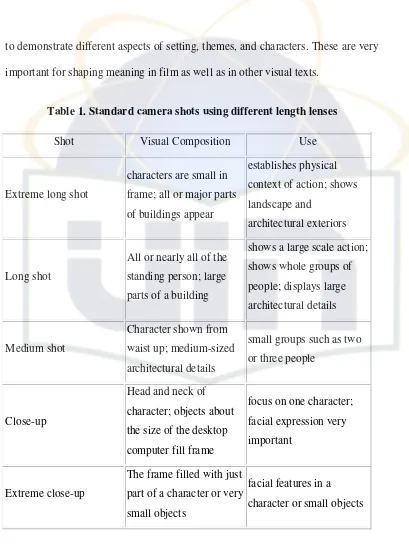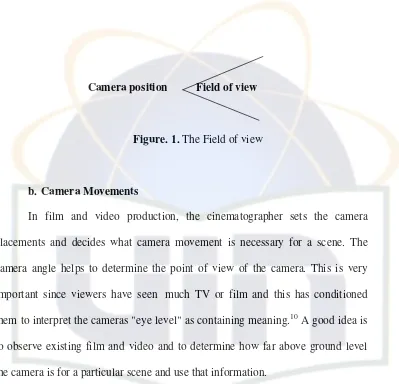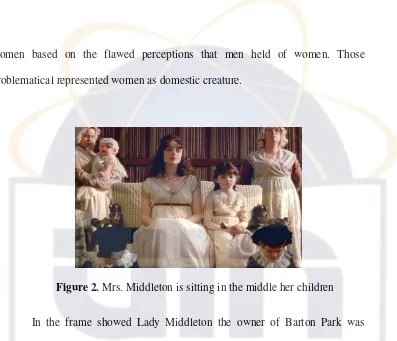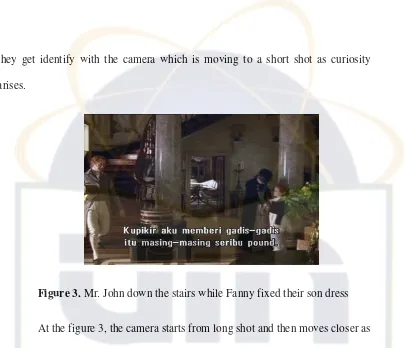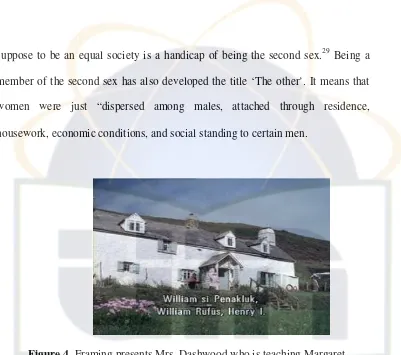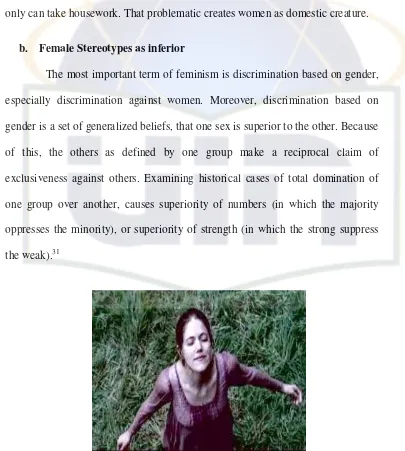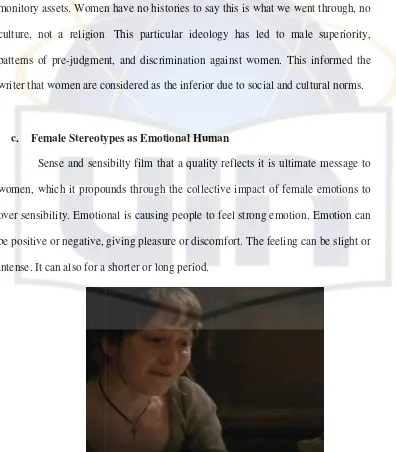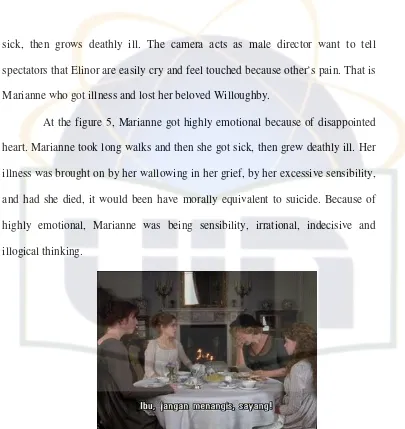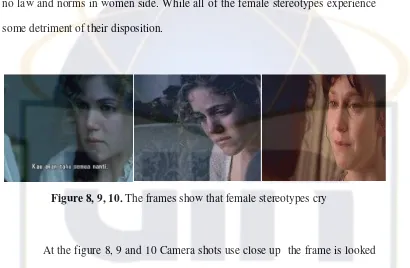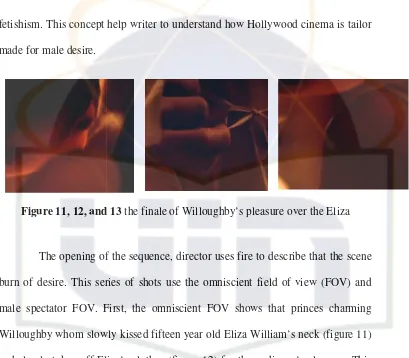REPRESENTATION OF FEMALE STEREOTYPES IN SENSE
AND SENSIBILITY FILM (2008) THROUGH
CINEMATOGRAPHY AND NARRATIVE ELEMENTS
TIRTA NYUMINNAR NIM 106026001029
ENGLISH LETTERS DEPARTMENT LETTERS AND HUMANITIES FACULTY
STATE ISLAMIC UNIVERSITY SYARIF HIDAYATULLAH JAKARTA
A Thesis
Submitted to Letters and Humanity Faculty
in Partial Fulfillment of the Requirement for
the Degree of Letters Scholar
TIRTA NYUMINNAR NIM 106026001029
ENGLISH LETTERS DEPARTMENT LETTERS AND HUMANITIES FACULTY
STATE ISLAMIC UNIVERSITY SYARIF HIDAYATULLAH JAKARTA
i ABSTRACT
Tirta Nyuminnar,Representation of Female Stereotypes in Sense and Sensibility Film (2008) through Cinematography and Narrative Elements. Thesis. Letters and Humanities Faculty, UIN Syarif Hidayatullah, Jakarta, 2011.
The study concerns on the representation of female stereotypes to express her idea through the film that appears in the film of Sense and sensibility. The writer uses the qualitative descriptive analysis as the method to analyze the relationship between characters, camera, and spectator, which are appeared in the Sense and Sensibility film. The data are obtained from the books of feminism, film, and literature and the internet, which are related with feminist film theory.
In this analysis, the writer finds out the result that shows the characteristics of female characters, which represents the female stereotypes in Sense and
Sensibility Film. Using Mulvey’s theory of Visual pleasure, this study identifies
ii
SENSIBILITY FILM (2008) THROUGH CINEMATOGRAPHY AND NARRATIVE ELEMENTS
A Thesis
Submitted to Faculty of Adab and Humanities In partial Fulfillment of the Requirements for
The Degree of Strata 1
Tirta Nyuminnar
106026001029
Approved by: Advisor,
Drs. Asep Saefuddin, M.Pd
NIP. 19640710 199303 1 006
ENGLISH LETTERS DEPARTMENT FACULTY OF ADAB AND HUMANITIES
STATE ISLAMIC UNIVERSITY SYARIF HIDAYATULLAH JAKARTA
iii
LEGALIZATION
The thesis entitled “Representation of Female Stereotypes in Sense and Sensibility Film (2008) through Cinematography and Narrative Elements” has been defended before the Letter and Humanities Faculty’s Examination Committee on January 27, 2011. The thesis has already been accepted as a partial fulfillment of the requirement for the degree of Letters Scholar.
Jakarta, February 14, 2011
Examination Committee
Signature Date
1. Drs. Asep Saefuddin, M.Pd
NIP. 19640710 199303 1 006
(Chair Person)
2. Elve Oktafiyani, M.Hum
NIP. 19781003 200112 2 002
(Secretary)
3. Drs. Asep Saefuddin, M.Pd
NIP. 19640710 199303 1 006
(Advisor)
4.
Inayatul Chusna, M.Hum
NIP. 19780126 200312 2 002
(Examiner I)
5.
Muh. Supardi, M. Hum
NIP.
iv
my knowledge and belief. It contains no material previously published or written by another person nor material which to substantial extent has been accepted for the award of any other degree or diploma of the university or other institute of higher learning, except where due acknowledgement has been made in the text.
Jakarta, January 12, 2011
v
ACKNOWLEDGEMENT
In the name of Allah, the Most Gracious, the Most Merciful.
First of all, the writer would like to thank to Allah SWT for all favor and guidance in completing this paper. All praise belongs to Him, the Creator of living things from being nothing to existence. Many solutions and benediction be unto the noblest of the prophet and messenger, Muhammad SAW.
On this occasion, the writer would like to express a special thanks to her father Pitoyo and her mom Arnita who give her their full financial, spiritual support and all the contribution during her study and the process of making this paper. Thank you for bringing her into this world and taking care of her patiently and affectionately since the writer was child. Thanks for always being there for her.
Thanks to her sisters and brother (Dian Suminnar SE., Sinta Ayunda Putri, and Noval Rahmat Reza). They always give her support and pray so that their pray may recharge her spirit. Let’s show that our parents are the most fortune parents because they gave birth to great human beings. Thanks to her aunt Ratna and her family who has been her second family when the writer was student in UIN. Thanks for their guidance, support, and contribution during her study since she stayed in her house.
The writer cannot fail to mention her advisor Drs. Asep Saefuddin, M. Pd. for his guidance and contribution in finishing this thesis, thank you very much for being patient in giving her advice to finish this thesis. Your correction, criticism, and broad perception give her lots of lessons.
The writer would like to thank to important people who have helped her from the beginning of outline until the outline become a complete work. They are:
1. Dr. H. Abdul Wahid Hasyim, MA, as the Dean of Adab and Humanities.
2. Drs. Asep Saefuddin, M.Pd. the Head of the English Letters Department.
3. Elve Oktafiyani, M.Hum, the Secretary of the English Letters Department.
4. All of the lecturers in English Letters Department whom the writer cannot mention one by one who have taught and educated her during her study in UIN.
5. Mrs. Inayatul Chusna M. Hum, for guiding her and helping in finishing this thesis. Thanks for your time, patience, and kindness. Thank you for never getting tired of teaching her and giving her advice.
vi
8. All of her work team in PT. A.W. Faber Castell Indonesia, especially, Mr. Daniel, Mba Ana, Mba Tachy, Mas Oni and Pak Djati for support, advise and kindness.
Finally, the writer’s great thanks to the entire place that gave her pleasures within her study process.
Jakarta, January 12, 2011
vii
CHAPTER II. THEORETICAL FRAMEWORK... 7
A.Concept of Representation ... 7
B. Cinematography Elements ... 8
a. Camera placements ... 8
b. Camera movements ... 10
c. Lighting ... 11
d. Feminist Film Theory ... 11
C. Narrative Elements ... 13
a. Characterization and Character ... 13
b. Setting ... 14
c. Costume ... 15
CHAPTER III. RESEARCH FINDING... 16
viii
through Cinematography and narrative elements...21
CHAPTER IV. CONCLUSION AND SUGGESTION... 37
A. CONCLUSION ... 37
B. SUGGESTION ... 39
BIBLIOGRAPHY ... 40
1 CHAPTER I INTRODUCTION
A. Background of Study
Literature is simply ways of increasing our experience, of going place, of
doing things in our imagination that might never has a chance to do otherwise.
Literature is an art from whose medium is language, oral, and written. It differs
from three ways, they are first, it is concentrated and meaningful, and second it is
that purpose is not simply to explain, argue, or make a point but rather to give
sense of pleasure in discovery of new experience and the last it demands intense
concentration from readers.1 Literary works come in several forms such as poetry,
novel, drama, and film.
About film, film is another alternative of media for narrating a story.
Film is considered an important art form, a source of popular entertainment and
powerful method for education or indoctrinating citizen. The task of film is to
make those processes available for debate, whether they are deliberate or
unconscious, individual or collective, human or institutional. In order that, film
needs theory. During the 1990s the digital revolution in image technologies has
had an impact on film theory in various ways. In the 1960s and 1970s, film theory
took up residence in academe, importing concepts from established disciplines
1
like psychoanalysis, gender studies, anthropology, literary theory, semiotics and
linguistics. The aimed of film theory is to explores the essence of the cinema and
provides conceptual frameworks for understanding film's relationship to reality,
the other arts, individual viewers, and society at large.
Moreover, the aimed of films bring important meaning and contain social
message for the spectator. The messages that are brought by a film are frequently
related to the social phenomenon based on the setting time. Feminism is a social
movement that has had an enormous impact on film theory and criticism. The
development of feminist criticism was influenced by second wave feminism and
the development of women's studies within the academy. Feminist scholars began
taking cues from the new theories arising from these movements to analyzing
film.2 After that feminist theory are rapidly developed. One of them is Feminist
Film Theory (Cinefeminism). Feminist Cinema is taken by feminists to be a
cultural practice representing myths about women and femininity.3
Feminism was popular in the early eighteenth century. Patriarchal value
was dominantly at that year. The conditions of women were very difficult. They
did not have many rights and were financially dependent on their husband or
families. An average wife spent some 15 years either in a state of pregnancy or in
nursing a child for the first year of its life.4 Women were exploited domestically.
2
Anonymous, feminism, accessed on March 27, 2010. http://en.wikipedia.org/wiki/Feminist _Film_theory.htm
3
Anneke Smelik, Feminist Film Theory in Pam Cook and Mieke Bernink, (eds), The Cinema Book, second edition (London: British Film Institute, 1999), p. 491.
4
3
They could not enter public field. Mother was nurturing and teaching their
children – the activities which most of women do it in 18th century. Feminist have
worked hard to advancement of women in social and politic field. They tried to
liberate women from inferiority and minority by use film.
Related to previous explanation, Sense and Sensibility Film is a film with
the setting time at the early eighteenth century. Sense and Sensibility film is a
2008 British television serial adapted by the BBC from Jane Austen's novel of the
same name. Sense and Sensibility Film was written by Andrew Davies and
directed by John Alexander. It was nominated for several Awards; BAFTA TV
Awards Nominated Best Original Television Music - Martin Phipps, Costume
Designers Guild Awards Nominated Outstanding Costume Design in a Miniseries
or TV Movie - Michele Clapton, Primetime Emmy Awards Nominated
Outstanding Cinematography for a Miniseries or Movie - Sean Bobbitt Nominated
Outstanding Music Composition for a Miniseries, Movie or Special (Original
Dramatic Score) - Martin Phipps.5
Sense and Sensibility is a story of two young sisters, Elinor and Marianne
Dashwood who face uncertain future. After their father died, they left Norland
Park with their mother and their young sister. They are dismayed to learn that
their inheritance consists of only £500 a year. John Dashwood, Mr. Dashwood's
eldest son from his first marriage, inherits his father's entire estate, under the laws
of primogeniture. The conflict in this film is the two sister’s love entangled with
their new status. Sense and sensibility film shows spectators from the point of
5
view of the minority. It represented women as victims of social structure. This is
the reason why the writer intends to examine the representation of women that is
reflected through cinematography and narrative elements based on feminist film
theory.
B. Focus of Study
According to the background of problem above, this research would be
concentrated in how film presents female stereotypes and exploitation through the
combination of the patriarchal order of society, and looking in itself as a
pleasurable act of voyeurism based on cinematic, framing, and dialog. The usage
cinematography and narrative elements that are perspectives of the male director
and the male spectator as they see the female character on screen and perspective
of male spectator that occur in film which serve to sexually objectify women.
C. Research Questions
Based on the background of study above, the statement of problem is:
How does Sense and Sensibility film represent female stereotypes
through cinematographic and narrative elements?
D. Significance of the Study
The writer hopes the result of the research will be advantageous to her
5
in understanding the message which is delivered in the film. Besides that, the
writer hopes that this research can be a contribution for others especially culture
and literature studies in State Islamic University Syarif Hidayatullah Jakarta.
E. Research Methodology
1. The Method of The Research
Based on research question and the significance of the study above, the
writer applies description qualitative method, which is analyzing the relation
among words or sentences that produces particular meaning.
2. Technique of Data Analysis
The data is analyzed based on the method and the approach of feminism
liberal. First, the writer watches the film carefully for several times. It is aimed to
learn and understand the contents of film. Then the writer analyzed female
characters with give annotation about the film. Finally, the writer relates it to the
feminist theory.
3. Instrument of Research
The instrument is the way that is used to obtain the data or information
that is needed in research.6 The instrument used in this research is the writer
herself as the subject of the research by reading the data taken from the script’s
film by signifying, grouping, giving a note to the required data, collecting data
and interpreting the meaning of the data.
6
4. The Unit of Analysis
The unit in this research is the film sense and sensibility directed by John
Alexander released on 2008.
5. Time
7 CHAPTER II
THEORETICAL FRAMEWORK
A. The Concept of Representation
The concept of representation has to come to occupy a new and important
place in study of culture. Representation began with early literary theory in the
ideas of Plato and Aristotle, and has involved into a significant component of
language, Saussurian and Communication studies.7 Representation is essential
part of the process by which meaning is produced and exchanged between
members and culture. Representation describes the signs that stand in for and take
the place of something else. It is through representation people know and
understand the world and through the act of naming it. Signs are manipulated in
order to make of the world. For many philosophers, both ancient and modern, man
is regarded as the “representation animal’ or homo symbolic, the creature whose
distinct character is the creation and the manipulation of signs things that “stand
for’ or “take the place of” something else.8
Representation has been associated with aesthetics (art) and semiotics
(signs). It is system by which all sorts of objects people and event are correlated
with a set of concepts or mental representations, which the directors carry around
in the spectator’s mind. Without them, we could not interpret the world
7
Mitchell, W. “Representation”, in F Lentricchia and Mc Laughlin, Critical Terms for Literary Study 2nd edn, (Chicago: University of Chicago Press, 1995),
8
meaningfully at all. For examples are our concepts of war, death, friendship, or
love. It means that is speaker or the author who imposes his or her unique
meaning on the world through language. Our shared conceptual map must be
translated into a common language, so that the reader can correlate the author’s
concepts and ideas with certain written words, spoken sounds, or visual images.
Words mean what the author intends that they should mean. With this approach
and theories above writer has purpose to represent women in Sense and Sensibility
Film.
B. Cinematographic Elements
According to Oxford learner’s Dictionary, film is a series of moving
pictures recorded with sound that tells a story, shown on television or the cinema.9
The story refers to a making story that is created based on either imagination or
reality. In film or video scene consists of a sequence of shots. Each shot is made
from a different perspective and then they are joined together. In film, the
cinematographer sets the camera shots and decides what camera movement is
necessary for a scene.
a.Camera Placements
It is important to differences between camera movements and camera
placements. Camera movements are used to position the viewer so that they can
understand the relationships between the characters. Camera placements are used
9
9
to demonstrate different aspects of setting, themes, and characters. These are very
important for shaping meaning in film as well as in other visual texts.
Table 1. Standard camera shots using different length lenses
The Field of View (FOV) is the angle described by a cone with the vertex
at the camera's position. It is determined by the camera's focal length, with the
shorter the focal length the wider the FOV.
Shot Visual Composition Use
Extreme long shot
characters are small in
frame; all or major parts
of buildings appear
shows a large scale action;
shows whole groups of
small groups such as two
or three people
Close-up
Head and neck of
character; objects about
the size of the desktop
computer fill frame
focus on one character;
facial expression very
important
Extreme close-up
The frame filled with just
part of a character or very
small objects
facial features in a
Camera position Field of view
Figure. 1. The Field of view
b. Camera Movements
In film and video production, the cinematographer sets the camera
placements and decides what camera movement is necessary for a scene. The
camera angle helps to determine the point of view of the camera. This is very
important since viewers have seen much TV or film and this has conditioned
them to interpret the cameras "eye level" as containing meaning.10 A good idea is
to observe existing film and video and to determine how far above ground level
the camera is for a particular scene and use that information.
1. A bird's eye angle (animation on right) is an angle that looks directly down upon a scene. This angle is often used as an establishing angle, along with an extreme long shot, to establish setting.
2. A high angle (animation on right) is a camera angle that looks down upon a subject. A character shot with a high angle will look vulnerable or small. These angles are often used to demonstrate to the audience a perspective of a particular character. The example above demonstrates to us the perspective or point of view of a vampire. As a viewer, we can understand that the vampire feels powerful.
3. An eye-level angle (animation on right) puts the audience on an equal footing with the character/s. This is the most commonly used angle in most films as it allows the viewers to feel comfortable with the characters.
10
11
4. A low angle (animation on right) is a camera angle that looks up at a character. This is the opposite of a high angle and makes a character look more powerful. This can make the audience feel vulnerable and small by looking up at the character. This can help the responder feel empathy if they are viewing the frame from another character's point of view. 11
c. Lighting
Lighting is one important element in film that is capable to conduct eyes to
the most important object in a frame. Lighter and darker areas within the frame
help create overall composition of each shot and thus guide our attention to
certain objects and action.12 Lighting furthers the audience’s understanding of
characters, underscores particular actions, develops themes, and established
mood.13
d. Feminist Film Theory (Cinefemists)
Issues of representation and spectatorship are central to feminist film
theory and criticism.14 Feminist film theory or cinefeminism is a particular
application of poststuctural-feminist approach to culture studies.15 Early feminist
criticism was directed at stereotypes of women, mostly in Hollywood films. Most
of these plays raise question about the expectation that women will become
11
Anonymous, Camera Movement, accessed on August 10 , 2010. http://www.film-overview. htm p. 2.
12
David Bordwell and Kristin Thompson, Film Art: An Introduction, (New York: McGraw Hill, Inc, 1993), p.152.
13
Maria Pramaggiore and Tom Wallis, Film: A Critical Introduction, (London: Laurence King Publishing Ltd, 2005), p. 77.
14
Anneke Smelik, (1999), op.cit. p.353.
15
mothers and the centrality of nurturing and pasificity to idea of feminist.16 A
feminist film focuses on production that are shared by many women, but it also
attends to differences of race, history, class, sexuality, and nation, alongside and
as part of theoretical difference feminist theory.
Laura Mulvey (in Shaw and Janet Lee) identified the “male gaze” (male
director’s project male fantasies onto female characters which viewers then
internalize) as a primary motif for understanding gender in filmmaking. Mulvey
argues that feminist movies are essentially made through and for male gaze and
fulfill a voyeuristic desire of men to look women as objects.17 Feminist film critics
focus on the ways in which the male directorial gaze constitutes women as objects
for men and ignores aspects of sexual politics and power transacted between both
men and women on the screen and between the film (maker) and audience off
screen.18
Cinefeminism differs markedly from liberal feminist studies of the content
of filmic images of women, rejecting this approach as overly positivist.19 It is
equally as important to examine ways in which women are signified or
represented. Postructural feminists focus on film because films are significant
screen of power. The films are being women as objects by pretending that the
cinematic gaze is somehow value free. The three of the cinematic gaze (camera,
Contemporary Reading 2nd Edition, (New York: Mcgraw Hill, 2004), p. 388.
18
Ben Agger (1992), op. cit. p. 127.
13
character, and spectator) that objectify the female character and make her into
spectacle. Male gaze has become shorthand term for the analysis of complex
mechanisms in cinema that involve structures like voyeurism and narcissism.
These concepts help to understand how Hollywood cinema is made for male
desire.
C. Narrative Elements
Narrative is a chain of events in a cause effect relationship, occurring in
time and space. A narrative is not a random string of events. Usually, the agaents
of cause and effect are characters. By reacting to events, they create causes and
react to the twist and turns in the story.
a. Characterization and Character
Many readers believe that plot is the most crucial element to their
enjoyment of a story, but most of us soon recognize that no matter how exciting,
eventful, or surprising the plot of a short story, novel, and film may be, we care
most about finding convincing portrayals of human nature in action. The method
by which writers create, reveal, and develop characters is called
characterization.20 Writers usually focus on a single character and show us the
complexities, contradictions, and difficulties in that person’s life and personality.
A major character is an important figure at the center of the story’s action or
theme. Sometimes this central character is the protagonist.
20
Character is changed in some a ways by experience. Characters who
remain relatively unchanged are called static. Characters who through some
development are called dynamic. The central characters in most short stories are
round (They have fully developed complex personality that may defy simple
analysis and description). Less significant characters in the story are likely to be
flat.
Finally, some characters in fiction lend themselves to neither kind of
analysis. Instead, they may represent abstraction or ideas rather than complex
human beings in action. When the fiction writer is primarily interested why
character choose and respond as they do their motivation we as readers must
respond by seeking and explanation for their behavior. We have to pay attention
to the list of characters and carefully read whatever descriptions the playwright
has provided. Characters have several properties. They usually have a body. They
possess traits such as attitudes, skill, psychology, drives, details of dress and
appearance, habits, etc.21 The viewer seeks to connect events by casual motivation
of characters.
b. Setting
Causes and effects take place in time. In sample terms, setting is the time,
place, and social reality within which a story takes place.22 Setting seems to be an
insignificant element in some stories. Setting is important for additional reason: it
symbolize the emotional state of the characters. In which place is an important
21
Aaron Sherwood, Characterization, Narrative Structure and Mythopeia in The Film of Hayao Miyazaki, (Vancouver: Regent College, 2006). p.3
22
15
elements of setting, the writer usually provides specific, sometimes extended
description of that place, focusing especially on those particular details that most
important to our understanding of the story. 23 As reader, we need to have a clear
sense of the place because that perception is central to our interpretation of
character, conflicts, and meaning. The time period is more significant than place.
Setting is also an important element in establishing the tone in a work of fiction.
c. Costume
Costumes are always important, because they tell us something about the
people who wear them.24 Costume can be especially symbolic. Costumes also
provide information about time and place. By integrating costumes may function
to support the film narrative and thematic patterns. Costume identified the
character. Costume employee decided to differentiate the sisters by contrasting the
colors of their wardrobes, having the "flighty" and "artistic" Marianne wear bolder
shades of red, yellow and purple compared to the more modest hues of Elinor's
attire. Marianne is thoroughly youthful, impetuous, and thoroughly immersed in
romantic ideals. Contrasted with her sister, Elinor tempers, her emotions, and
judgments with good sense and discretion. She prefers to keep her troubles secret.
Willoughby's costume was also designed to reflect his "fashionable" personality,
while Colonel Brandon's trench coat and dark shades were intended to make him
seem an old-fashioned, stronger character. The costumes really helped to get into
character and that they were "absolutely beautiful" to look.
23
Joseph F. et. al, (2002) op. cit, p. 6.
24
16 A. Data Description
1. Representation of Female Stereotypes in Sense and Sensibility Film (2008) through Cinematography and Narrative Elements
Feminist is the problematic issue that is taking place around 1800s
England. Patriarchal society is society structure at that time. Patriarchal society is
social structure that allowed men to have power, especially economic and political
power, while women were exploited, especially domestically. Women were legal
infant, and her conducts were determined by many rules. They could not enter the
profession or study at the university, and society had sketched out the outlines of a
perfect woman pretty clearly. To leave political, legal and military affairs - the
masculine sphere to men, to regard marriage as the only ambition worth having, to
concentrate humbly only to her husband, her children and her home and to behave
graciously and elegantly – that was the ideal woman.
Published in 1811, Sense and Sensibility is a novel by the English novelist
Jane Austen. Sense and Sensibility story is taking place early 18th century. Austin
wrote the first draft of Elinor and Marianne (later retitled Sense and Sensibility) in
epistolary from sometime around 1795 when she was about 19 years old. Sense
and sensibility did not tell about super women. It is a story about two siblings
17
discrimination towards women. The story reflected social phenomena around
1800’s. Austen realized that patriarchal society dominantly at that time. It helps
Sense and Sensibility Film with making stereotype for women and men. This
stereotype helped men to have power and exclusive. The writer analyzes female
stereotypes wih using cinefeminists, which is presented by John Alexander in
Sense and Sensibility Film. Cinefeminists focus on the gestural and directorial
ways in which film women are represented by the male director and represented
by the male audience. Instead, cinefeminist directors refocus the camera on the
ways in which men objectify women acquiesce fatefully to their own
objectification.25 After doing a deeply examination, the writer finally finds some
representation of female stereotypes which reflect with social phenomena in 18th
expression. (in minute 04:00, 3rd disc )
The camera then uses close up lense again to show Elinor facial expression. (in minute 22:40, 3rd disc) 4. Sexual Object
This series of shots use the omniscient FOV creates naked body male and female,
Perspectives of male spectators that occur in film which serve to sexually
21
B. Analysis
1. Representation of Female Stereotypes in Sense and Sensibility Film (2008) through Cinematography and Narrative Elements
The essential poststructural thesis of cinefeminism is that the camera shot
is not neutral. Cinefeminist likens the camera to male gaze.26 Which is the male
gaze of camera presents women as sexual object, prostitute, lesbian and mother.27
Camera focuses on the ways in which the male directorial gaze constitute of
women as object for men and ignores aspect of sexual politics and power
transacted between men and women in the screen. Feminist criticisms have
pointed to the "male gaze" that predominates in classical Hollywood filmmaking.
Sense and Sensibility film shows discrimination, stereotyping, objectification
(especially sexual objectification), oppression, and patriarchy to women
characters. In this case, the Cinematography and narrative elements have helped
in bringing the patriarchal value of Sense and Sensibility Film.
a. Female Stereotypes as Domestic Creature
In the patriarchal family, a woman does not have a freedom to determine
what she wants to choose. Women must obey their parents in childhood, their
John, J. Macionis. Society: The Basics, (New Jersey: Prentice Hall, 1996), p. 378. objectify women.
women based on the flawed perceptions that men held of women. Those
problematical represented women as domestic creature.
Figure 2. Mrs. Middleton is sitting in the middle her children
In the frame showed Lady Middleton the owner of Barton Park was
sitting in the middle around her children that Lady Middleton was welcoming
Mrs. Dashwood and the girls when they visited Barton Park. The camera shot has
helped bring “soft patriarchal message.” The camera starts from long shot, and
then the camera gets closer and closer and comes to close up and pause when
Lady Middleton finally whispers the word. She was looked pale.
The camera acts as male director who wants to tell more and more that
women supposed to be. The camera presents women in their very own sphere.
Lady Middleton is central to her family as wife, mother, and lover. The genteel,
but reserved wife of Sir John Middleton, she is quieter than her husband is, and is
primarily concerned with mothering her four spoiled children and savages than to
23
they get identify with the camera which is moving to a short shot as curiosity
arises.
Figure 3. Mr. John down the stairs while Fanny fixed their son dress
At the figure 3, the camera starts from long shot and then moves closer as
following Mr. John Dashwood is walking down stairs while Mrs. Fanny and their
son are standing in the corner of framing only. She is fixing their son’s dress. The
camera shot presents within the space is then crucial as disruption of patriarchal
values developed within patriarchal ideology itself. Those women were nurturing
and carrying her children while men could do whatever and go wherever they
want but not to do what women did.
Women represent the most inferior forms of human evolution and that
they are closer to children in this film. The camera shot shows that there is no
equal parenting to nurturing the children. Society believes that women were never
suppose to be an equal society is a handicap of being the second sex.29 Being a
member of the second sex has also developed the title ‘The other’. It means that
women were just “dispersed among males, attached through residence,
housework, economic conditions, and social standing to certain men.
Figure 4. Framing presents Mrs. Dashwood who is teaching Margaret
At the figure 4, using camera shots long extreme, the framing shows Mrs.
Dashwood and Margaret in front of their house. This camera acts have three
means. First, the image presents Mrs. Dashwood as a mother; she has
responsibility that is not only nurturing her children but also teaching them. The
activity, which was most of women, do it in 18th century.
Second, Margaret was looked study that she learnt about King and
Queen of England. Women of the 18th century cannot take education in school as
men. Girls received less education than boys did. It means women cannot take
29
25
variety field. Furthermore, almost working fields were limited for women.
Women only can take domestic field.
Last, the house is as not only background in framing but also the male
director wants to convince the spectators about women only can spend their life at
home. Borrowed Simone de Beauvoir word that an image of "the woman in the
home.”30 Women cannot take profession in variety field. In other words, women
have nature responsibilities that only can take housework. Women are exploited
domestically.
One of the definitions a woman is a female person who plays a
significant role (wife or mistress or girlfriend) in the life of a particular man.
Societies also see women being known as one of the others due to dualities.
Socialization is the process by which representatives of society teach people the
ways of society and, in so doing, form their basic qualities. Through socialization,
people learn the ways of society and internalize these ways. Moreover,
socialization is also the process by which individual qualities and directions
people take in life are created. Nonetheless, women are socialized with an
ascribed status. The ascribed status female role was still as the good wife and
mother, who primary responsibility was that of a homemaker.
MARGARET
Willoughby is scoundrel is you think mom.
MRS DASHWOOD King and Queen Meg!!
30
[...]
MARGARET I wish I were not a sister Women cannot do anything
Man can around the countries and do things And girls just sit and wait what can happen.
From the dialogue, it can be seen a statement of a child which is honest,
brave, and critical. It is an extraordinary thing for a child to state the opinion even
just to think about it. In this sequence, Margaret analyzes condition that happens
to women. By the time, women really do not have power for her own life. Women
in patriarchal culture have no chance to consider their orientation. In generally
women does not have freedom to determine what she wants to choose. Women
are in this way completely dependent on men.
Based on that dialog, it can be seen difference between man and woman.
That dialog describes women as "lacking,” an "incidental being,” and as
"imperfect men.” Sense and Sensibility film realizes us that humanity as a whole
is dominantly male and defines women as relative to him. In addition, a wife must
wait on hands and foot to her husband. Women cannot take variety field. They
could not enter the profession or study at the university. Furthermore, almost
working fields were limited for women. Women only can spend their life at home.
Women in eighteenth century always want marriage as the only ambition
worth having, to concentrate humbly only to her husband, her children and her
27
watches appearance, and pays attention to her family so that it becomes perfect. A
wife must serve every detail of her husband’s needs and give birth the babies.
MARIANNE:
Oh, Elinor!
I keep thinking about the poor girl with the baby. What strange grievances man of?
ELINOR: Yes, indeed
MARIANNE:
What they want from us?
ELINOR: I cannot done to you
MARIANNE:
Perhaps they see us not as people but as playthings, Elinor.
From the dialog, Marianne and Elinor analyzed the condition of Charlotte
Jennings Palmer. Mrs. Palmer is jolly and laughs at inappropriate things, such as
her husband’s continual rudeness to her and others. In patriarchal culture, women
will say “yes” to everything her husband decide. Women were moved by man’s
hand. They do not have anything that they can admit their own. After they see
Mrs. Palmer, Marianne and Elinor realized that women are the one who give birth
and have the primary responsibility for her children and her husband ongoing.
Based on the dialog and framing, definition of woman is what man
decides it is; and while men are independent of women, the opposite is definitely
not true. Sense and Sensibility film realizes us that the women around have no
dominantly at that year. In additional, men tend to be conquest driven while it is
natural for women to be more concerned with nurturing. In other words, women
only can take housework. That problematic creates women as domestic creature.
b. Female Stereotypes as inferior
The most important term of feminism is discrimination based on gender,
especially discrimination against women. Moreover, discrimination based on
gender is a set of generalized beliefs, that one sex is superior to the other. Because
of this, the others as defined by one group make a reciprocal claim of
exclusiveness against others. Examining historical cases of total domination of
one group over another, causes superiority of numbers (in which the majority
oppresses the minority), or superiority of strength (in which the strong suppress
the weak).31
Figure 5. Camera and male spectators look upon of Marianne
31
29
This frame (figure 5) uses bird eyes level camera placement. The camera
looks upon a subject. Camera shots Marianne with a high angle. This shot does
put the audience in a godlike position, looking down on the action. This picture
above illustrate that Marianne takes long, melancholic walk in the rain, thinking
about how close Willoughby’s house, while at Cleveland as a natural consequence
of her long walks.
She does not really think before she acts, and believes firmly that one
should be directed by feelings, not logic. She cannot face her disappointed heart
of Willoughby. She cannot realize that Willougbhy has leave her and married with
Miss Shopia Grey in order to retain his comfortable lifestyle. That are starting
point of the implicit inferiority of women. It was because Marriane is uncreative,
afraid of conflict, and skeptical of change. The camera acts can be made Marianne
to look insignificant,vulnerable, powerless, or small.
Women have been seen inferior to men in every way possible. In 18th
century, Women have nothing that they can claim as their own. Society was very
patriarchal during that time. Men were in control of all monitory assets. The
whole laws about legacy, marriage, and divorce align to men and the rules to
neutralize those authorities are almost nothing. Women only have what men allow
them to have, that they have taken nothing but only received.
MR. DASHWOOD
MR. DASHWOOD
Without your help, Your step mother and the girls almost have nothing. You must do something. You have to promise me
[...]
ELINOR It is his house now
According to the law, in 18th century the first son got entire estate after
their father died. This is actually the trajectory of sense and sensibility, “house go
from father to son, dearest – not from father to daughter. It is the law.” The three
misses Dashwood and their mother were thrown out from their mansion in
Norland. And They only have what John Dashwood allow them to have that the
three misses Dashwood and their mother were left penniless consists of only £500
a year.
Regarding to discussion above female stereotypes in Sense and
Sensibility film are showed who are though as powerless. They cannot deny their
right as When a man died, his money was actually passed on the closest living
male heir. The death of the father ensures the trajectory of social identity loss.
Women have always been a man’s dependent that is why she is not seeing as
equally. Women were looked insignificant contrast with men. MARGARET
But why Elinor! It is not fair, isn’t it?
ELINOR
That is the way thing Meg!
Society was ve
ery patriarchal during that time. Men were in co
en have no histories to say this is what we went t
n. This particular ideology has led to male s
ent, and discrimination against women. This inf
considered as the inferior due to social and cultur
types as Emotional Human
sibilty film that a quality reflects it is ultimate m
ounds through the collective impact of female e
ional is causing people to feel strong emotion. Emo
, giving pleasure or discomfort. The feeling can b
a shorter or long period.
6. Elinor is crying to see Marianne who get deathl
6, the camera starts from long shots and slowly c
ose up and pause. When camera is slowly closer
sick, then grows deathly ill. The camera acts as male director want to tell
spectators that Elinor are easily cry and feel touched because other’s pain. That is
Marianne who got illness and lost her beloved Willoughby.
At the figure 5, Marianne got highly emotional because of disappointed
heart. Marianne took long walks and then she got sick, then grew deathly ill. Her
illness was brought on by her wallowing in her grief, by her excessive sensibility,
and had she died, it would been have morally equivalent to suicide. Because of
highly emotional, Marianne was being sensibility, irrational, indecisive and
illogical thinking.
Figure 7, Mrs. Dashwood is crying in front of her daughters
Using camera movement medium shot shows small groups (Mrs.
Dashwood and her daughter). They are gathering to have a breakfast. However, a
letter comes from John Dashwood. John Dashwood has entire estate now after
their father died. The letter tells that He and His family will come to stay in his
house. In other words, Mrs. Dashoowd and her daughter have to leave Norland
33
have nothing after her husband died. She also cannot do anything because there is
no law and norms in women side. While all of the female stereotypes experience
some detriment of their disposition.
Figure 8, 9, 10. The frames show that female stereotypes cry
At the figure 8, 9 and 10 Camera shots use close up the frame is looked
only Head and neck of Marianne and Elinor. The aim of this camera placement is
to see image’s facial expressions. All of frame happens when Elinor and Marianne
spend their winter at Mrs. Jenning’s home in London. Marianne has written a
series of letters to Willoughby. However, Marianne’s letters go unanswered. At
the figure 8, Marianne is crying while writing disappoint letter to Willoughby
after Willoughby snubs her coldly when he sees her at ball.
At the figure 9, Marianne is crying again after receive letter’s response
from Willoughby. He writes to Marianne, enclosing their framer correspondence
and love tokens, including a lock of her hair and informing her of his engagement
to Miss Grey. Marianne is devastated, and admits to Elinor that she and
Willoughby were never engaged, but she loved him and he led her to believe he
At the figure 10, The camera uses close up lense again to show Elinor
facial expression. Elinor is crying after she hides disappointment and works to
convince Lucy she fells nothing to Edward. This is particularly hard as she sees
Lucy tell and tell about her engagment and happy to Edward while Elinor realize
that she can not with Edward forever.
The frames show that women are around all day accountable bursting
into tears. The different between women and men that women are easily to cry to
express their emotion. Elinor and Marianne Dashwood are two central female
characters in Austin’s Sense and Sensibility. They are respectively represented
sense and sensibility. Marianne who got illness and lost her beloved Willoughby
and Elinor still indulges her disappointed heart. They are models of extreme
sensibility.
d. Female stereotypes as sexual objects
Probably, the best genre of film in which to observe gender is romantic
drama. Pearce and whisker define romantic love as ‘re/production of infantile
human desire and romance as the culture representation of that desire.”32 Female
stereotype function is as object of desire that expressed in term of this two steps
process of presentation and representation. Female characters are doubly
constructed according to desire both male camera and male spectator. The notion
of the male gaze has become a shorthand term for the analysis of complex
mechanisms in cinema that involve structures like voyeurism, narcissism and
32
fetishism. This concept
male, and female (figur
girl’s neck. The camer
t help writer to understand how Hollywood cinem
d 13 the finale of Willoughby’s pleasure over the
of the sequence, director uses fire to describe tha
eries of shots use the omniscient field of view (
First, the omniscient FOV shows that princes
wly kissed fifteen year old Eliza William’s neck
liza’s clothes (figure 12) for the audience’s plea
fferent point of view creates the imagination of na
re 13), which is then concluded by Willoughby
era then uses Willoughby’s eyes again to show
ack and again these shots for male spectator’s ple
main reasons for film developer to create film
r and male spectator’s sex appeal, or to defy th
ally attractive has strong appeal and will increase
While barely dressed seductive temptresses will always appeal to a male’s basic
primal instincts.
Figure 14, Willoughby took Marianne hair
Camera shot is placed beside Willoughby as Willoughby eyes to see
Marianne’s body. Women’s bodies are often dismembering into legs, breast,
thigh, or necks. The camera acts as sees Marianne’s neck. Camera placements
work to give male spectator’s pleasure. The depiction of Marianne as the passive
object of Willoughby’s male gaze evokes the male spectators’ identification with
Willoughby.
The camera placements and movements acts as Willoughby’s eyes. Thus,
humanity is male and man defines woman not in herself but as relative to him. This
empowers the male audience with the power to control the look and enjoy the
visual pleasure offered by the farming of female stereotypes as object in this
adaptation. Thus, she is called ‘the sex’, by which is meant that she appears
essentially to the male as a sexual being. Perspectives of male spectators that occur
37 CHAPTER IV
CONCLUSION AND SUGGESTION
A. Conclusions
In every narrative text such as film, novel, lyric, poem, etc the author will
describe his or her point of view how the society or even the world supposed to
be. The author creates new world – an imaginative world – which suit his or her
ideology. This filmmaker will potray the world which suits his or her concept. Be
The concept that he takes is his point of view about ideal world.
When a film is said to be based on a work of literature, it usually means
either film is an almost exact reproduction of the story remaining completely
faithful to its model, or it is an adaptation of the text in which original material is
reorganized or deleted, and new material is created added where necessary. The
film of Sense and sensibility is an example of an adaptation and it is based on Jane
Austin novel with the same titled “Sense and Sensibility.” New scene and
situation are created to round out and develop the story line. Sense and sensibility
film was directed by John Alexander and was written by Andrew Davies.
Regarding to discusion above that in Sense and Sensibility film, John
Alexander wants convience the spectators about women can not be equal at that
time. He shows how patriachal values developed. Which is men were in control of
all monitory assets. He can do whatever he want, he can go wherever and
all a daughter must be obiedient to her father’s will. And a wife must wait on
hands and foot to her husband. Women cannot take variety field. Women spend of
her rest time at home. Female stereotypes in sense and sensibility film represented
women domestic creature, inferior, emotional and sexual object.
From the previous chapter, The writer has explored the argument
suggested by Mulvey visual theory and narrative elements that feminist movies
are essentially made through and for male gaze and fulfill a voyeuristic desire of
men to look women as objects. Sense and sensibility film portrays female
characters with love, passion, kindness but in contrast males are not unconvincing.
Contrasted with male characters, female characters was created as passive
personae. With the critical use of camera’s point of view, the film also assigns
Female characters as the object of the look, which can be concluded that the 2008
Sense and Sensibility film has effectively employed selective cinematic
techniques to reveal representation of women with analyzed female character’s
characterization, camera movement, and framing based on male gaze. while at the
same time maintain her as the central focalization.
B. Suggestion
There are any other problems that can be analyzed from Sense and
Sensibility Film especially which not taken by the writer. In this era there are a lot
of literary theory that we can used to analyze literary works. The writer suggests
the reader to explore more about other problems because the literary works may
39
This research using visual pleasure theory from feminist fim theory to find
female stereotype is represented in Sense and Sensibility Film. Because the
limitation of time and in order to make the research specific, the writer focused on
female characters, camera movement, and framing based on male gaze. If the
reader want to use Sense and Sensibility as the object of study, the reader can
analyze feminism using feminist liberal and feminist film theory based on female
gaze. The reader also can analyze the social structure of the film, focusing on
gender and society and compare how men and women directors present characters
in films between Sense and Sensibility Film (1995) and Sense and Sensibility
40
Agger, Ben. Cultural Studies as Critical Theory. London: The Falmer Press, 1992.
Barnet, Sylvan et. al. An Introduction to Literature 12th edition. USA: Longman, 2001.
Beauvior, Simone de. The Second Sex, Translator : H.M. Parshley London: Vintage Classic, 1949.
Bordwell, David and Kristin Thompson. Film Art: An Introduction. New York: McGraw Hill, Inc. 1993.
Farkhan, Muhammad. Proposal Penelitian Bahasa dan Sastra. Jakarta: Cella Jakarta, 2007.
Hornby, AS. Oxford Advanced Learner’s Dictionary of Current English. Oxford: Oxford University Press, 2007.
Joseph F. et. al, Efictions. USA: Thomsom Learning, 2002.
Kutha, Nyoman. Sastra and Culture Studies Representasi, Fiksi dan Fakta. Yogyakarta: Pustaka Belajar, 2007.
M. O’Shaugnessy, And Stadler J, Media and Society: an Introduction 3rd edn, South Melbourn: Oxford University Press, 2005.
Macionis, John J. Society: the Basics, New Jersey: Prentice Hall 1996.
Mason H, Gloria et. al. Literature and Ourselves, A Thematic Introduction For Readers and Writers Fourth Edition. Newyork: Longman 2003.
Pearce, Lynne and Gina Wisker, Ed. Fattal Attraction-Rescripition Romance in Contemporary Literature Film. London: Pluto press, 1998.
Pramaggiore, Maria and Tom Wallis. Film: A Critical Introduction. London: Laurence King Publishing Ltd, 2005.
41
Smelik, Anneke. Feminist Film Theory in Pam Cook and Mieke Bernink, (eds), The Cinema Book, second edition. London: British Film Institute, 1999.
Stephanie, Natalia. Keterasingan Perempuan didalam Subjektivitas Maskulin, Sebuah Analisis Kritis atas Tatanan Simbolic Jacques Lacan. Depok: Fakultas Ilmu Pengetahuan Bahasa. Universitas Indonesia, 2009.
Tylee, Claire M. et. al. War Plays by women an International Anthology. London: Routledge, 1999.
W. Mitchell, “Representation”, in F Lentricchia and Mc Laughlin, Critical Terms for Literary Study 2nd edn, Chicago: University of Chicago Press, 1995.
Website:
Anonymous, Camera Movement, accessed on August 10 , 2010, http://www.film-overview.htm
Anonymous, The Eighteenth Century, accessed on January 31, 2011 www.uk.filo.pl/uk-_history_8_htm
Anonymous, feminism, accessed on March 27, 2010
http://en.wikipedia.org/wiki/Feminist_Film_theory.html
Anonymous, sense and sensibility (2008), accessed on March 17, 2010
http://en.wikipedia.org/wiki/Sense_and_Sensibility_(2008_TV_serial).htm
Picture 1
Picture 5
Picture 9
Picture 13
42
Picture 2 Picture 3 Pic
Picture 6 Picture 7 Pic
Picture 10 Picture 11 Pict
Picture 14 Picture 15 Pict
icture 4
icture 8
icture 12
Picture 17
Picture 21
Picture 25
Picture 29
Picture 33
Picture 18 Picture 19 Pict
Picture 22 Picture 23 Pict
Picture 26 Picture 27 Pict
Picture 30 Picture 31 Pict
Picture 34 Picture 35 Pict
43
icture 20
icture 24
icture 28
icture 32
Picture 37
Picture 41
Picture 45
Picture 49
Picture 53
Picture 38 Picture 39 Pict
Picture 42 Picture 43 Pict
Picture 46 Picture 47 Pict
Picture 50 Picture 51 Pict
Picture 54 Picture 55 Pict
icture 40
icture 44
icture 48
icture 52
45
